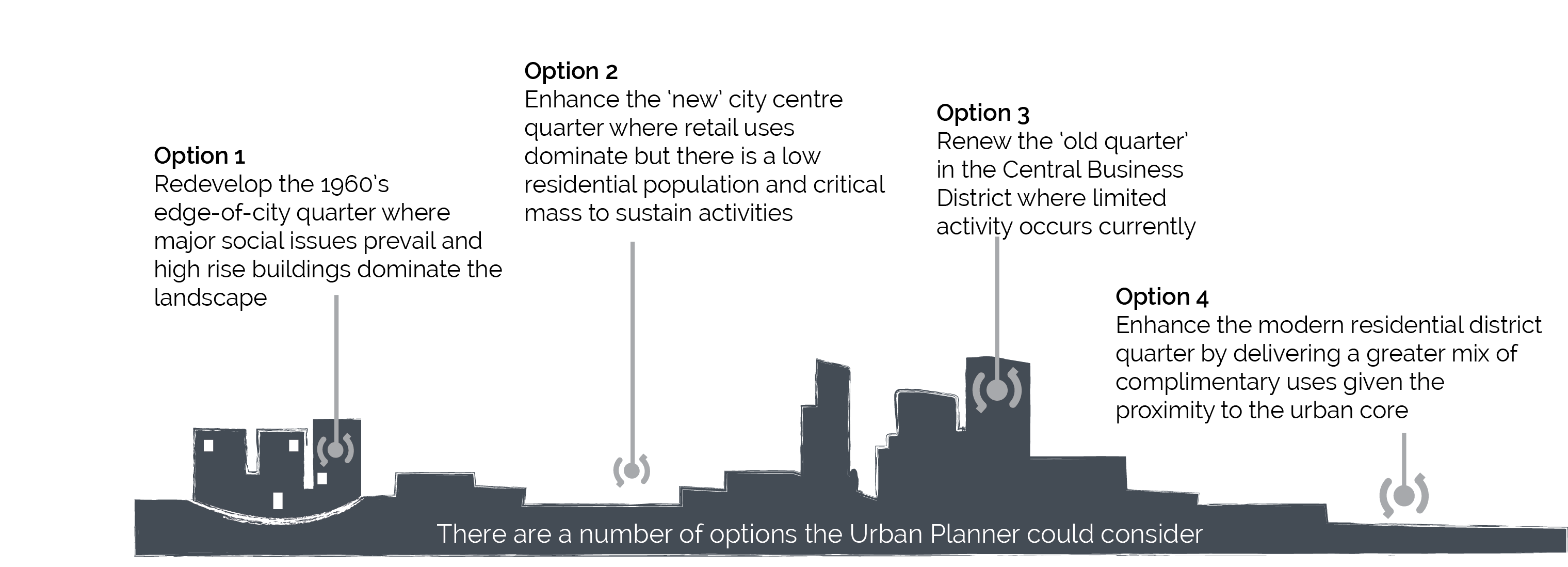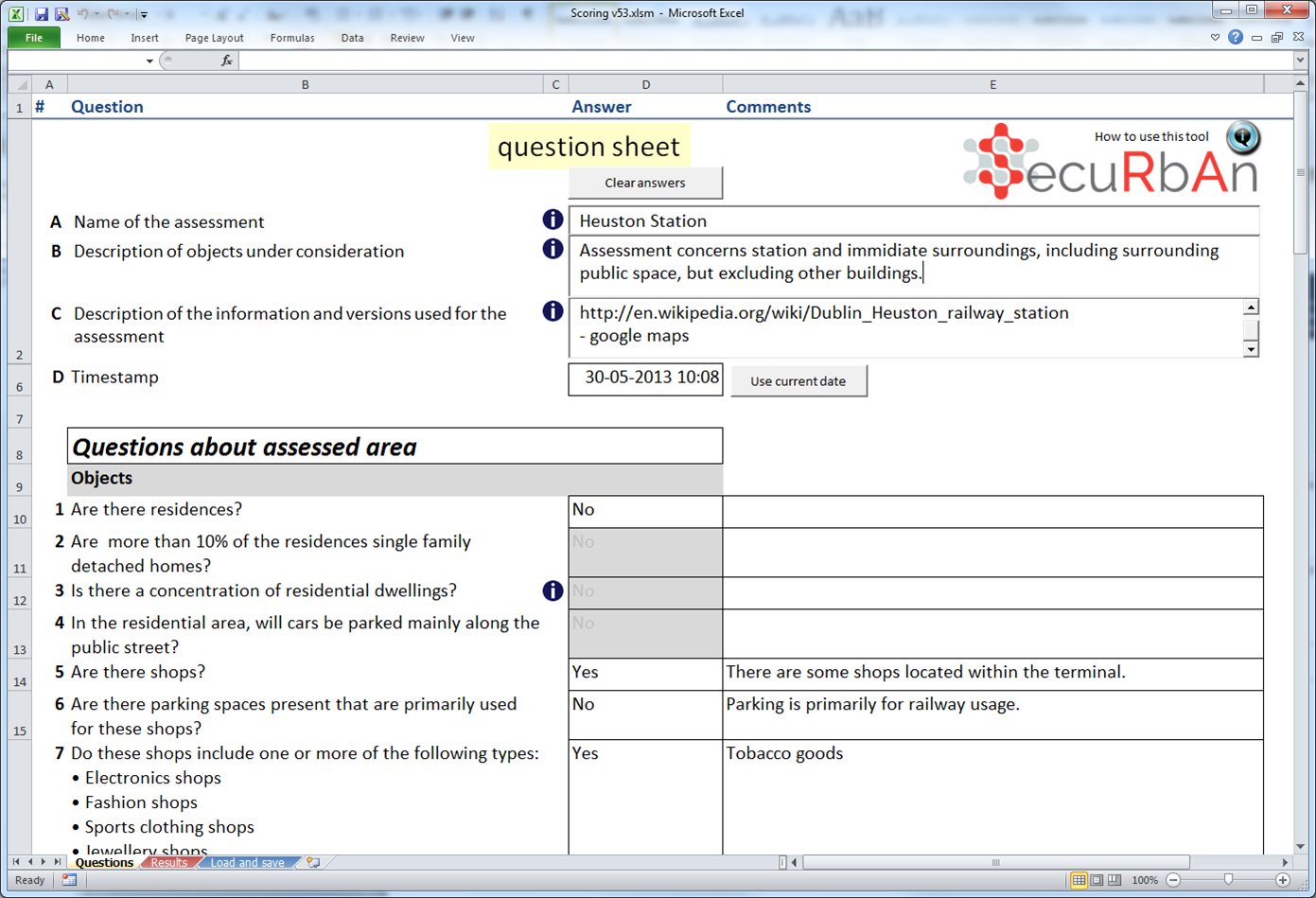Difference between revisions of "How to Use the Concept Tool"
| Line 48: | Line 48: | ||
[[File:Cityscape.png|center|800px|In this example scenario, there are a number of options the Urban Planner could consider]] |
[[File:Cityscape.png|center|800px|In this example scenario, there are a number of options the Urban Planner could consider]] |
||
=== Simple Risk Assessment === |
|||
At the outset, the urban planner may select to make use of '''secuRbAn to perform a simple risk assessment of the existing option areas s/he has identifed above'''. A series of questions is posed to determine the attractiveness, circumstances and vulnerabilities of the object of the various types of offenders. For example, a risk assessment for Option 1 may identify that, given the presence of a football stadium where very large crowds are frequently present, there may be some heightened concerns to locate another regional attractor there (i.e. a mixed use, including major retail uses, scheme). SecuRbAn will have direct links to this Securipedia knowledge base where, for example, information on the impact of large crowds (e.g. pickpocketing, vandalism, etc) can be researched by the urban planner to help him/her in the risk assessment and to make a more informed decision. |
|||
=== Focus on a particular element === |
|||
Next, '''the urban planner may focus on a particular element of a project'''. So, if the proposed regeneration scheme includes a significant residential component, and the urban planner is considering Option 2 (an area where there is a low population base but a dominance of retail activity), the secuRbAn and securipedia combined will assist the planner in deliberating whether the mixed use (including residential) scheme would be compatible. Is the existing retail stock struggling with theft or other criminal issues? What measures have been implemented and how effectives have they been? Would the provision of further retail use, together with the creation of an increased local residential population, compound the existing problems, or creat new solutions,such as 24/7 natural surveillance of homes, shops and public spaces? |
|||
=== Heading text === |
|||
=== Initial Set-Up Phase === |
=== Initial Set-Up Phase === |
||
Revision as of 08:52, 26 February 2013
This How-to-Use Guide explains the relationship between the two Concept level tool components:
- SecuRbAn Risk Assessment Tool;
- Urban Securipedia Knowledge Base.
The page is structured to provide a short description of the two tools, followed by a visual depiction of the interaction between the tools.
Contents
Components of the Concept Tool
| Tool Component | Description |
|---|---|
| SecuRbAn, the Risk Assessment tool, is a supporting tool for doing a quick security scan to indicate where possible security issues may arise. It will facilitate the urban planner in making a quick assessment of the security issues that are most relevant to a project or scheme. | |
| Urban Securipedia is the Concept Tool's Knowledge Base providing the background understanding on subjects that are directly or indirectly related to security for the urban planner. |
Relationship between Concept Tool components
Application Scenario
In order to explain how to use the VITRUV Concept Tool (i.e. Securban and Securipedia), let us consider a typical scenario that an urban planner may deal with in undertaking his/her duties: A city is concerned with its poor position in economic competitiveness in comparison with the European average for cities of a similar scale. A number of weak urban quarters within the city have been identified for an urban regeneration programme intended to stimulate wider development and economic growth and renewal. A mixed use scheme to facilitate the delivery of residential dwellings, office and retail floor space, together with a range of services and facilities, is envisaged. Limited investment and resources restrict the selection to a single quarter, and this will be based on an assessment of available data, including demographic, socio-economic and infrastructural needs. An assessment of the security (and connected safety) of the area will also form part of the process.
Simple Risk Assessment
At the outset, the urban planner may select to make use of secuRbAn to perform a simple risk assessment of the existing option areas s/he has identifed above. A series of questions is posed to determine the attractiveness, circumstances and vulnerabilities of the object of the various types of offenders. For example, a risk assessment for Option 1 may identify that, given the presence of a football stadium where very large crowds are frequently present, there may be some heightened concerns to locate another regional attractor there (i.e. a mixed use, including major retail uses, scheme). SecuRbAn will have direct links to this Securipedia knowledge base where, for example, information on the impact of large crowds (e.g. pickpocketing, vandalism, etc) can be researched by the urban planner to help him/her in the risk assessment and to make a more informed decision.
Focus on a particular element
Next, the urban planner may focus on a particular element of a project. So, if the proposed regeneration scheme includes a significant residential component, and the urban planner is considering Option 2 (an area where there is a low population base but a dominance of retail activity), the secuRbAn and securipedia combined will assist the planner in deliberating whether the mixed use (including residential) scheme would be compatible. Is the existing retail stock struggling with theft or other criminal issues? What measures have been implemented and how effectives have they been? Would the provision of further retail use, together with the creation of an increased local residential population, compound the existing problems, or creat new solutions,such as 24/7 natural surveillance of homes, shops and public spaces?
Heading text
Initial Set-Up Phase
The first step will involve the urban planner setting up a file for his/her new project.
1. Log into the Concept Tool;
2. Enter your name/ID of the specific analysis (something easy to remember);
3. Enter a short description of the project:
a. Be clear on what is, and is not, included;
b. Data sources, data revisions/versions being used;
c. Describe any grouping of objects;
d. Have any measures already been used in the project formulation to date?
Please note that the visual below reflects an early version mock-up screen of the secuRbAn tool, and so may be significantly different to the final product.
SecuRbAn (and supporting Securipedia) Risk Assessment Phase
4. SecuRbAn will now take you through a series of questions to determine:
a. The presence of attractive objects to certain crime types;
b. Attributing circumstances;
c. Protection measures.
5. The questions which SecuRbAn will ask will depend on the answers you provide to the previous round of questions. For example, if you identify through the first round of questions that there is a heightened attractiveness within the proposed regeneration area for breaking and entering by an offender, SecuRbAn may probe further into this aspect.
Output Phase
6. From the previous phase, the tool will output a list of security issues in two ways:
- Prioritised (sorted) list of relevant security issues to be addressed in the project
- This list will include links to Securipedia, traces to the answers that gave rise to the list, and user notes you inserted during the question phase;
- BEST FOR: A quick overview of the issues to be dealt with.
- A complete (sequential) lost of all possible security issues with a scoring indication of its possible relevance to the project.
- BEST FOR: A quick identification of the change between two risk assessments.


